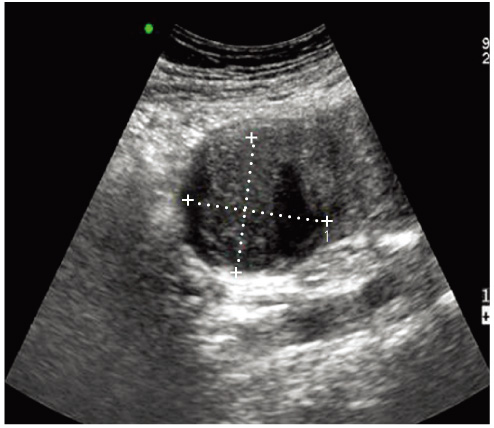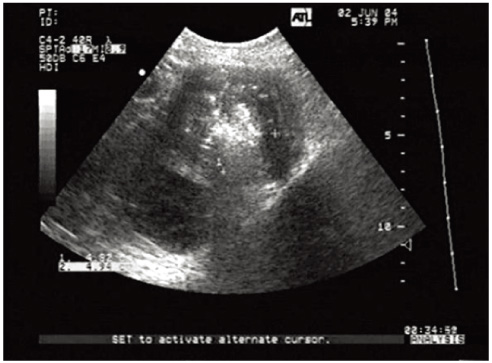Korean J Obstet Gynecol.
2011 Aug;54(8):480-483. 10.5468/KJOG.2011.54.8.480.
A case of pregnancy and childbirth after transvaginal radiofrequency myolysis in infertile women
- Affiliations
-
- 1Department of Obstetrics and Gynecology, Asan Medical Center, University of Ulsan College of Medicine, Seoul, Korea. chnkim@amc.seoul.kr
- KMID: 2274071
- DOI: http://doi.org/10.5468/KJOG.2011.54.8.480
Abstract
- Transvaginal radiofrequncy myolysis is minimally invasive treatment by creating thermal energy in myoma and causing the necrosis of uterine fibroid cells. Unlike myomectomy which is considered to be the most common treatment of uterine myoma in infertile women, transvaginal radiofrequncy myolysis can be performed as outpatient procedure using only sedation for pain relief without additional need for medication. Due to its less invasive approach, the hospitalization is not required. There are many published studies reporting the pregnancy complications and outcomes after myomectomy, but there are very limited data on pregnancy after myolysis. Therefore, we present a case of successful pregnancy and childbirth after transvaginal radiofrequency myolysis of uterine myoma in an infertile women with a brief review of the literature.
MeSH Terms
Figure
Reference
-
1. Buttram VC Jr, Reiter RC. Uterine leiomyomata: etiology, symptomatology, and management. Fertil Steril. 1981. 36:433–445.2. Nisolle M, Smets M, Malvaux V, Anaf V, Donnez J. Laparoscopic myolysis with the Nd:YAG laser. J Gynecol Surg. 1993. 9:95–99.3. Zupi E, Sbracia M, Marconi D, Munro MG. Myolysis of uterine fibroids: is there a role? Clin Obstet Gynecol. 2006. 49:821–833.4. Donnez J, Polet R, Squifflet J, Rabinovitz R, Levy U, Ak M, et al. Endometrial laser intrauterine thermo-therapy (ELITT): a revolutionary new approach to the elimination of menorrhagia. Curr Opin Obstet Gynecol. 1999. 11:363–370.5. Donnez J, Squifflet J, Polet R, Nisolle M. Laparoscopic myolysis. Hum Reprod Update. 2000. 6:609–613.6. Ryu JH, Kim KH, Park JS, Yang YS, Oh KY, Rho JH, et al. Comparative analysis on the effectiveness of transvaginal radiofrequency myolysis for conservative management of leiomyoma and adenomyosis. Korean J Obstet Gynecol. 2008. 51:48–59.7. Luo X, Shen Y, Song WX, Chen PW, Xie XM, Wang XY. Pathologic evaluation of uterine leiomyoma treated with radiofrequency ablation. Int J Gynaecol Obstet. 2007. 99:9–13.8. Kanaoka Y, Yoshida C, Fukuda T, Kajitani K, Ishiko O. Transcervical microwave myolysis for uterine myomas assisted by transvaginal ultrasonic guidance. J Obstet Gynaecol Res. 2009. 35:145–151.9. Kim CH, Kim SR, Lee HA, Kim SH, Chae HD, Kang BM. Transvaginal ultrasound-guided radiofrequency myolysis for uterine myomas. Hum Reprod. 2011. 26:559–563.10. Georgakopoulos PA, Bersis G. Sigmoido-uterine rupture in pregnancy after multiple myomectomy. Int Surg. 1981. 66:367–368.11. Jung SA, Lee JJ, Park HY, Cha SH, Kim MK, Choi KY, et al. Two cases of cesarean section after laparoscopic radiofrequency myolysis. Korean J Obstet Gynecol. 2008. 51:676–681.
- Full Text Links
- Actions
-
Cited
- CITED
-
- Close
- Share
- Similar articles
-
- A case of normal spontaneous vaginal delivery after transvaginal radiofrequency myolysis
- Two cases of cesarean section after laparoscopic radiofrequency myolysis
- Clinical Study of Long Term Effect of Transvaginal Ultrasound Guided Radiofrequency Myolysis for Treatment of Uterine Leiomyoma
- A case of full term normal spontaneous vaginal delivery after radiofrequency myolysis
- Transvaginal radiofrequency myolysis for conservative management of uterine myomas



